Are you ready to dive into the fascinating world of stink bugs?
Today, we’ll introduce you to the incredible diversity of these little critters that call Montana their home.
From the rough stink bug to the Brown Marmorated Stink Bug, we’ll shed light on their shapes, sizes, and unique characteristics.
And no, they don’t just stink—they have a fascinating way of protecting themselves that involves a sour apple-scented spray!
- Related article: Bug Activity in Montana
Whether you’re a nature enthusiast, a curious explorer, or even an unfortunate victim of a stink bug invasion, this article is for you.
Buckle up as we embark on a journey through the world of Montana’s stink bugs. We’ll explore their impact on crops, their peculiar feeding habits, and even their charming yet repugnant defense mechanisms.
By the end, you’ll have a newfound appreciation for these often misunderstood creatures that roam our great state.
So, are you ready to join me on this enthralling—and slightly smelly—adventure? Let’s dive in and discover Montana’s stink bugs together!
11 Types of Stink Bugs Found in Montana
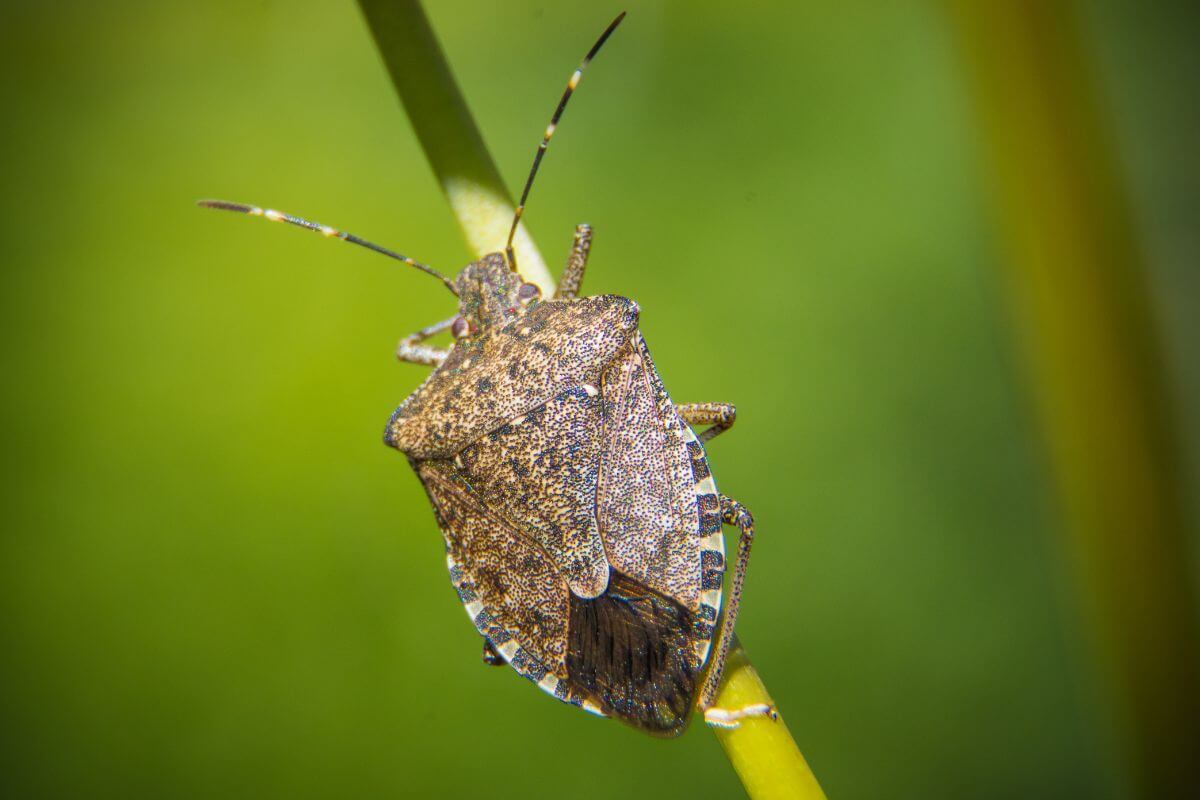
Montana is home to numerous species of stink bugs.
From the invasive Brown Marmorated Stink Bug to the predatory Spined Soldier Bug, each comes in different shapes and sizes and boasts unique features and habits.
Let’s check each of them out!
1. Brown Marmorated Stink Bug (Halyomorpha halys)
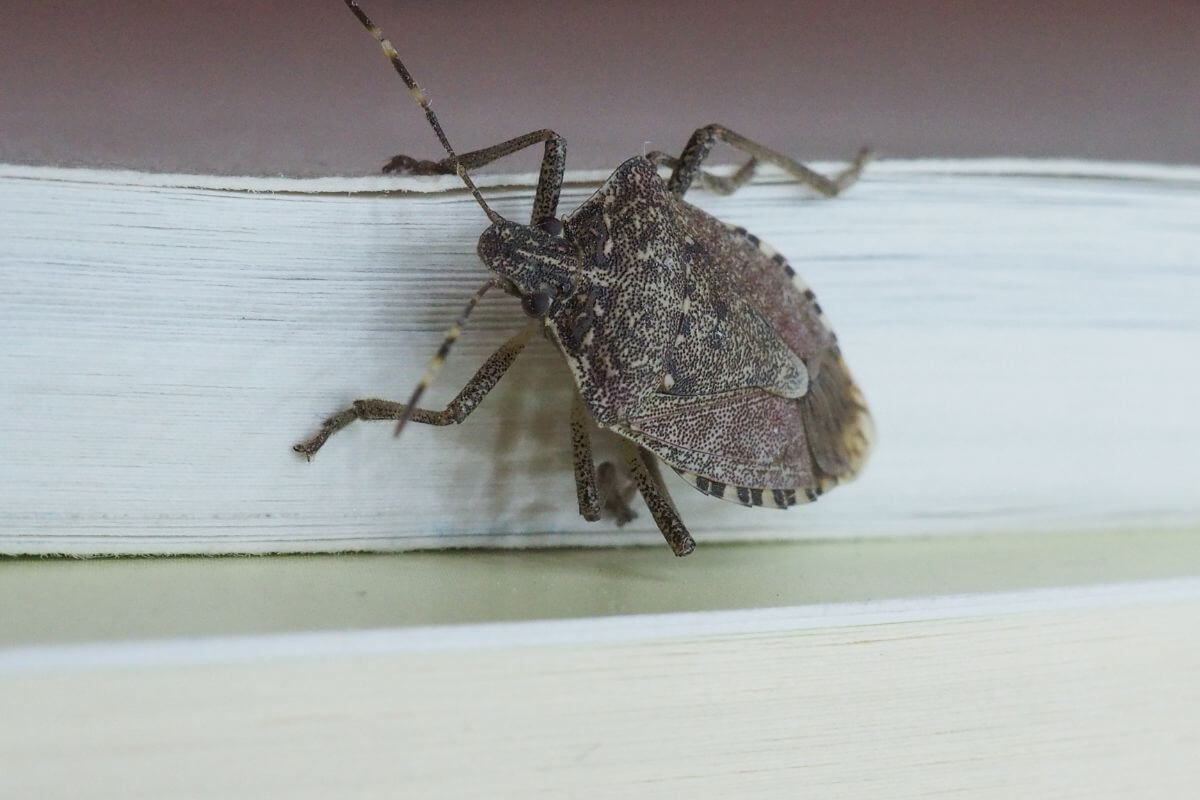
The Brown Marmorated Stink Bug (Halyomorpha halys), an invasive Asian insect pest, made its unwelcome arrival in the U.S. in the mid-1990s.
Since then, it has managed to spread its wings, so to speak, and can now be found in at least 46 states.
This bug, with its unmistakably mottled brown and metallic blue-green shield-like body, has become a real pain in the neck for many farmers and gardeners alike.
What makes the Brown Marmorated Stink Bug such a nuisance is its voracious appetite for various plants, including vegetables, fruit trees, crops, and delicate ornamental plants.
This particular stink bug may also be found feeding on jalapeño plants.
Amid the challenges posed by climate change, this invasive bug has been able to expand its range further north, even infiltrating Canada.
The warmer winters mean more generations can be produced in a single season, compounding the already significant problem.
But let’s not get too hung up on the negatives. It’s helpful to be able to identify this pest, especially if you’re in an area where it’s causing havoc.
The mature Brown Marmorated Stink Bug boasts a shield-shaped body marked with brown mottling.
It measures approximately 14 to 17 millimeters in length, which is akin to the size of a U.S. dime. Notably, its abdomen and the last two segments of its antennae display alternating broad bands of light and dark hues.
Now that you know what to keep an eye out for, remember that knowledge is power. Stay diligent, stay informed, and together, we can curb the impact of this pesky critter. Don’t let it take over your garden paradise!
2. Two-Spotted Stink Bug (Perillus bioculatus)
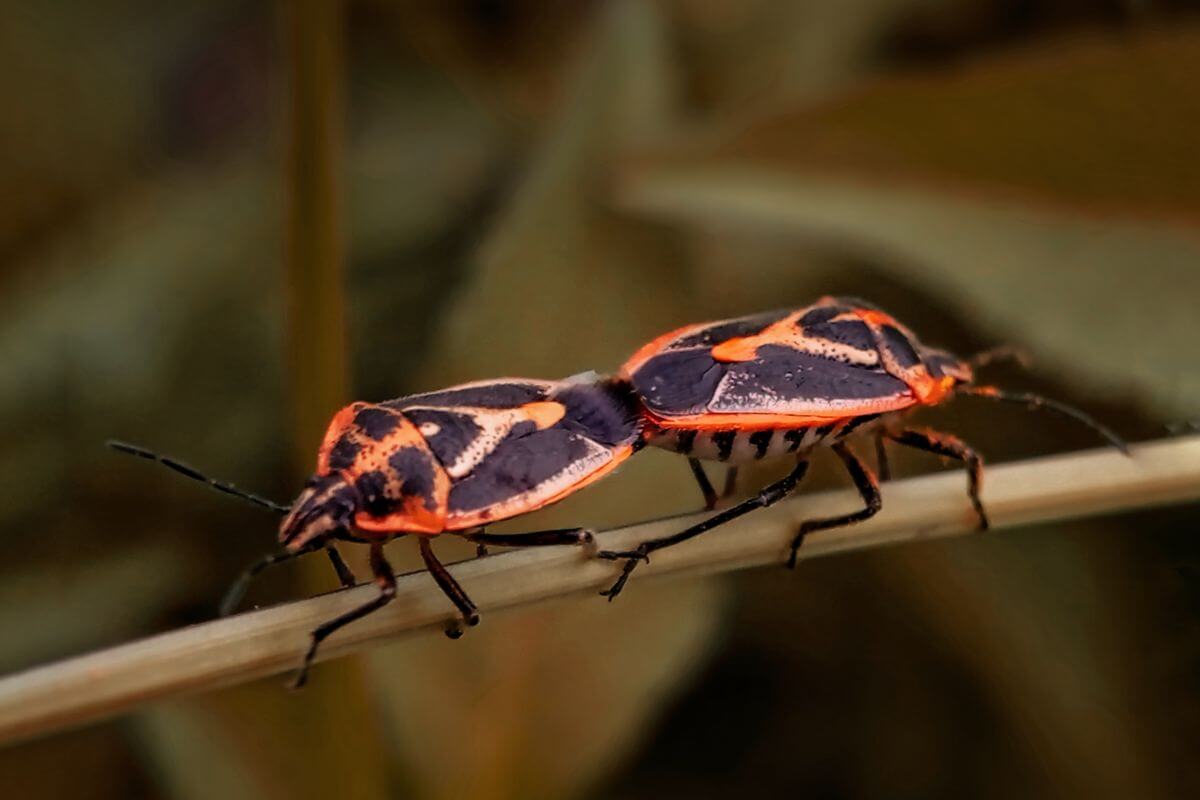
The two-spotted stink bug, also known as Perillus bioculatus, is a fascinating creature that can be found in various crops, gardens, landscapes, and wildlands.
These shield-shaped bugs, measuring about 10 millimeters long, display a striking black color with contrasting hues that can range from reddish-orange and pale green to white and yellowish.
Two-spotted stink bugs have a distinctive feature—two black spots adorning their prothorax, along with a scutellum that truly makes them stand out in the insect world.
Its life cycle consists of three stages: egg, nymph, and adult. It’s truly a marvel to witness the transformation of these bugs.
A female can lay up to a whopping 200 eggs, which typically hatch within a week. The nymphs start their journey by feeding on plant juices but eventually become predaceous, showing off their versatility.
With their tubular mouthparts that can extend forward, they are capable of consuming 300 to 400 leaf beetle eggs during their development stage. Once they reach adulthood, these impressive bugs can even devour approximately 80-leaf beetle larvae.
Not only are these bugs fascinating, but they also play a crucial role as helpful stink bugs. Two-spotted stink bugs feed on over 40 species of pest insects, aiding in the battle against unwanted garden visitors.
To enhance biological control and support these beneficial bugs, it is advisable to take certain measures.
Controlling ants, cultivating flowering plants, reducing dust, and avoiding broad-spectrum insecticides can encourage two-spotted stink bugs in your garden.
So, the next time you come across these insects, take a moment to appreciate their vivid coloration, distinctive markings, and incredible ability to help protect your plants.
Embrace their presence and support their efforts as they contribute to the ecological balance of your garden.
3. Redbanded Stink Bug (Piezodorus guildinii)
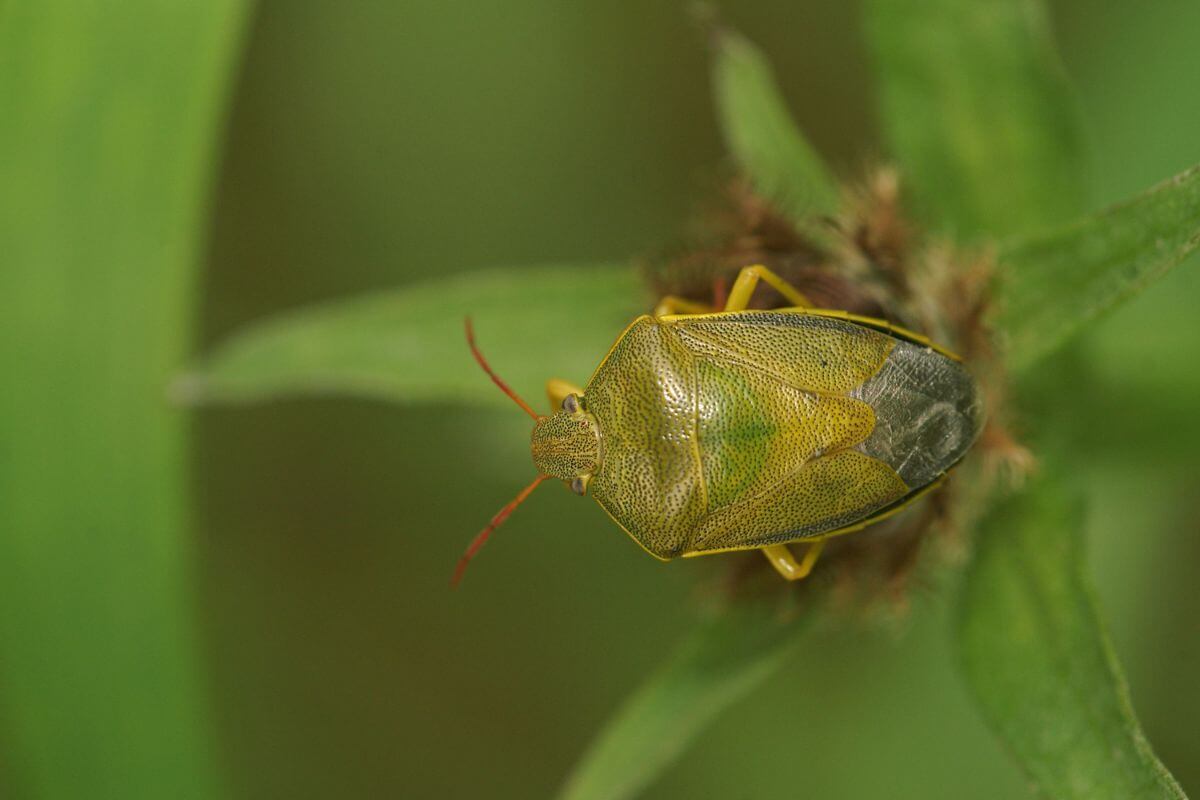
In the southeastern United States, a notorious pest has made its presence known—the redbanded stink bug, scientifically known as Piezodorus guildinii.
These small, glossy, green stink bugs have become a cause of concern due to their feeding habits and impact on economically important crops.
These bugs favor leguminous plants, like soybeans, causing significant crop damage with economic implications for South American farmers.
When it comes to physical characteristics, adult bugs are, on average, 8-11 millimeters in length and 4-6 millimeters in width across the pronotum.
The standout feature of an adult bug is the single band that extends across the pronotum, which can vary in color from cream to red. However, at times, these bands can surprise us with appearances in hues ranging from orange to deep purple.
That said, the most distinctive and easily identifiable characteristic of the adult redbanded stink bug is the long spine on the ventral side of its abdomen.
As this invasive pest continues to pose a threat to crops, farmers and researchers must monitor its presence and develop effective strategies for control.
By understanding the habits and characteristics of the redbanded stink bug, we can take targeted measures to protect our leguminous plants and ensure the sustainability of our agricultural practices.
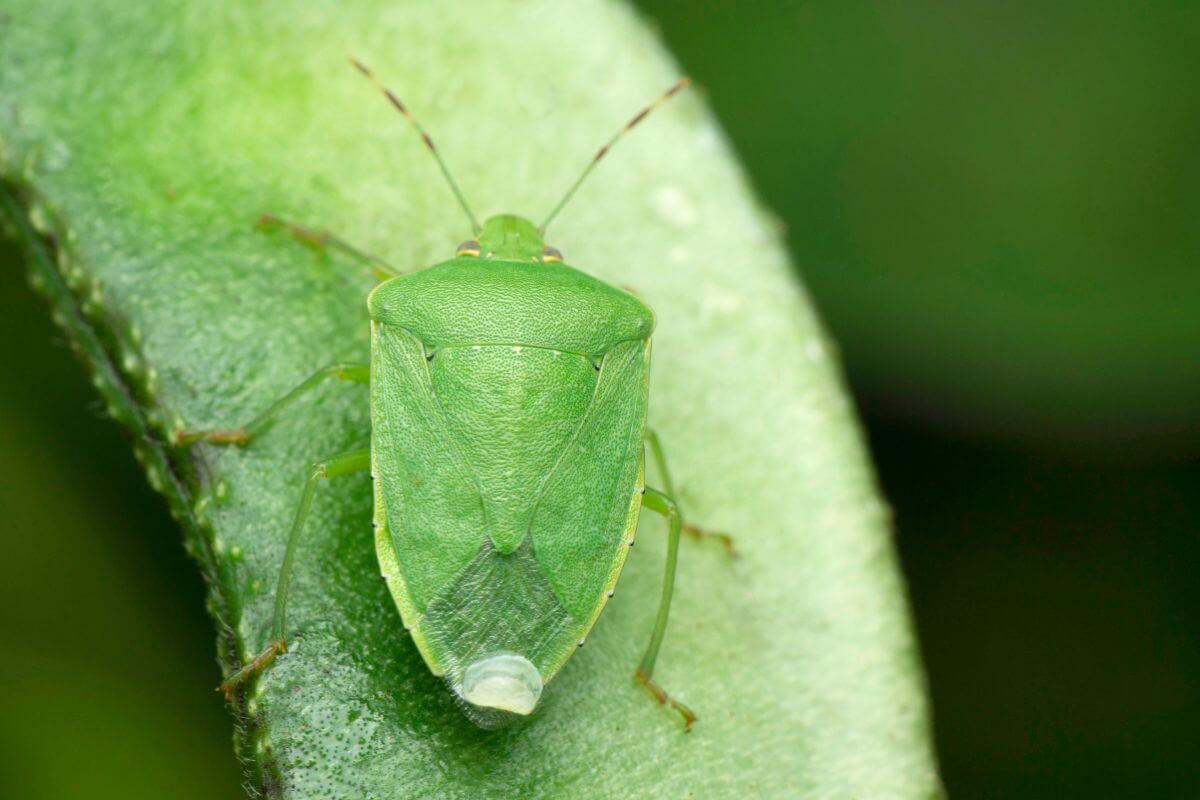
Adult green stink bugs, also known as Chinavia hilaris, exhibit a shield-shaped form and boast a vibrant light green hue.
Measuring between 14 to 19 millimeters in length, they often sport a slender orange-yellow border that traces along their heads and pronotum.
During the start of the year and in the early days of spring, you might chance upon these adults crawling amid leaf litter, seeking warmth on sunny days after the snow melts.
Their eggs, initially displaying a yellow-to-green color, eventually transition to shades of pink and gray. These clusters of eggs can be found carefully nestled on the underside of leaves.
When it comes to feeding habits, this bug has a diverse palate.
From black cherry and elderberry to blackberry, apples, peaches, and soybeans, the green stink bug is known to consume a variety of plants and fruits. It’s truly a culinary opportunist!
Luckily, nature has its own way of maintaining balance. Natural enemies such as birds, toads, spiders, and parasitic insects join forces to aid in the biological control of the green stink bug.
This intricate web of predator-prey relationships ensures that populations are kept in check, and our plant species can thrive.
Keep an eye out for the magnificent green stink bug, appreciate its vivid appearance and remarkable adaptability. It is a common stink bug with an uncommon charm.
5. Spined Soldier Bug (Podisus maculiventris)
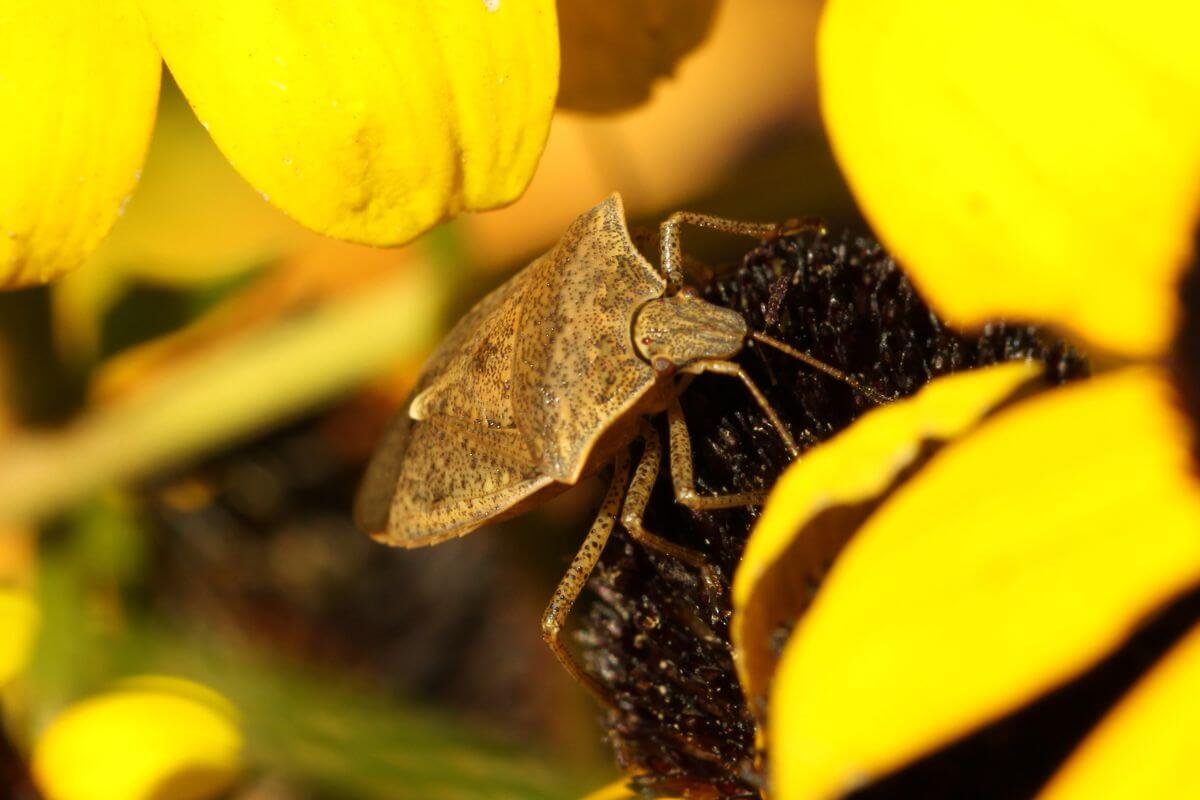
The Spined Soldier Bug, known in the scientific community as Podisus maculiventris, is a medium-sized predatory stink bug with a voracious appetite for other arthropods. It typically hunts down and feasts on the larvae of butterflies and beetles.
This bug is a superstar among predatory stink bugs, reigning supreme as the most common species in North America.
With its widespread presence, it has become intimately associated with various crops, including alfalfa, beans, cotton, cucurbits, eggplants, and potatoes, just to name a few.
This incredible insect patrols the fields, its distinct spined appearance marking it as a fierce predator. It lurks in the shadows, stealthily scanning its surroundings for any unsuspecting prey.
Farmers and gardeners alike hail the Spined Soldier Bug as a valuable ally. With its insatiable appetite for harmful insects, it helps keep pest populations in check, safeguarding the health and productivity of crops.
If you spot this predatory arthropod, appreciate its vital role in maintaining the delicate balance of our ecosystem.
6. Blue Shieldbug (Zicrona caerulea)
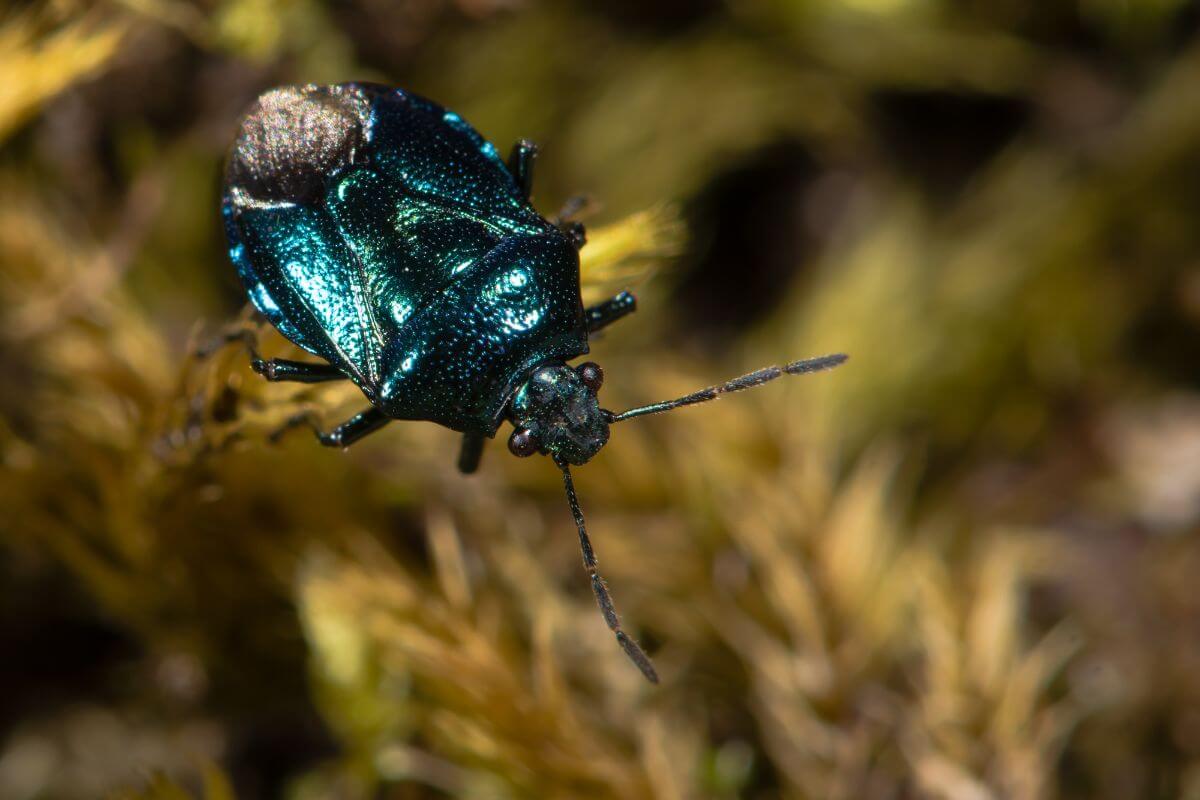
The blue shieldbug, scientifically known as Zicrona caerulea, captivates with its mesmerizing metallic blue-green shield and dark wing membrane.
During their nymph stage, these shieldbugs take on a different guise, appearing in vibrant shades of red with black spots. They resemble ladybugs, but with longer antennae and legs that give them a unique charm.
These remarkable creatures thrive in habitats such as damp grasslands and forest edges, where they can find the perfect blend of vegetation and moisture. Here, they fulfill their dual role as both predator and plant forager.
Blue shieldbugs are not picky eaters, feasting on the larvae of beetles, caterpillars, and moths in Montana, diligently hunting down their prey. Yet, they have a fondness for certain plant species, making them a valuable part of the ecosystem.
In a world full of diverse and fascinating insects, the blue shieldbug stands out with its radiant appearance and predatory habits, making it a captivating creature to behold.
7. Rough Stink Bug (Brochymena spp.)
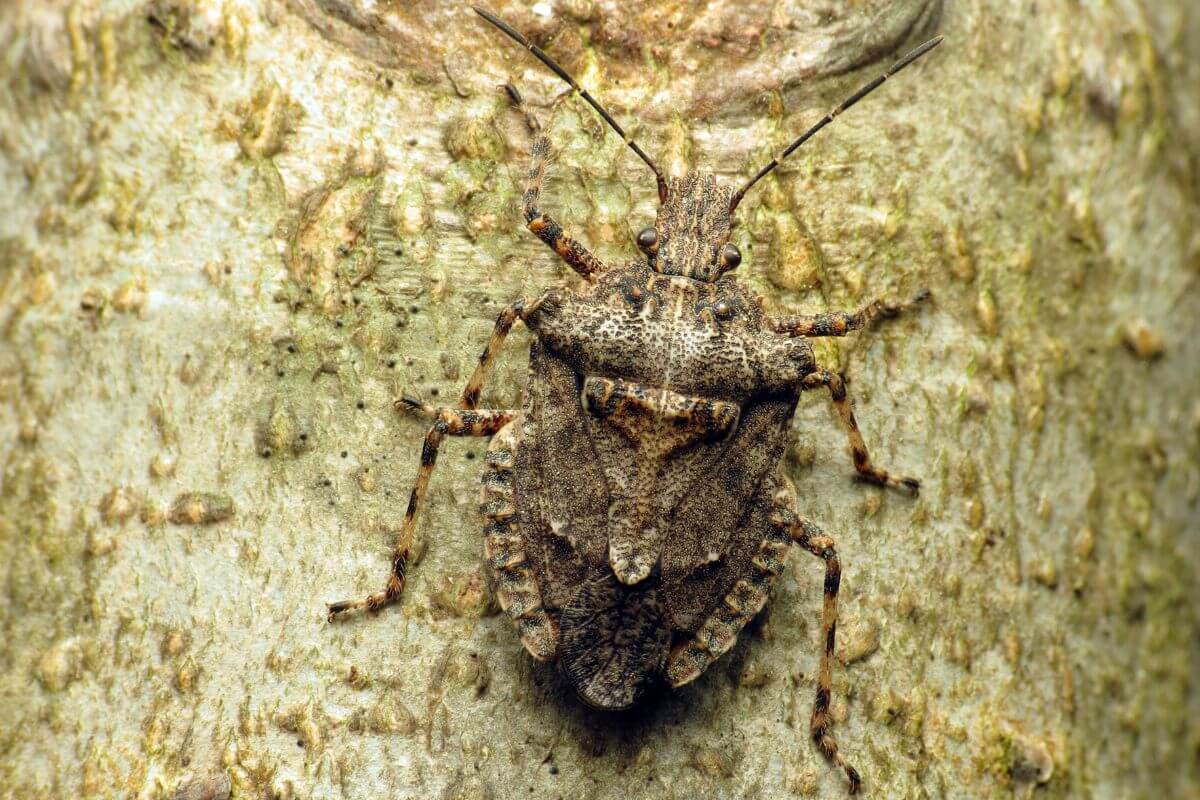
The adult rough stink bug, known scientifically as Brochymena spp., has a distinctive shield-shaped body and measures between 11-18 millimeters in length.
Its beauty lies in its mottled brownish or grayish color, adorned with intricate black, white, and at times, orange or yellow markings.
Feasting on caterpillars, larvae of leaf beetles, sawflies, and other openly feeding, relatively large, slow-moving, soft-bodied insects, rough stink bugs play a vital role in maintaining nature’s balance.
Rough stink bugs are meticulous hunters, efficiently selecting their prey to help control certain pest populations, thus contributing to the ecosystem’s balance.
Their presence in gardens and fields should not be underestimated, as their contributions are substantial.
8. One Spotted Stink Bug (Euschistus variolarius)
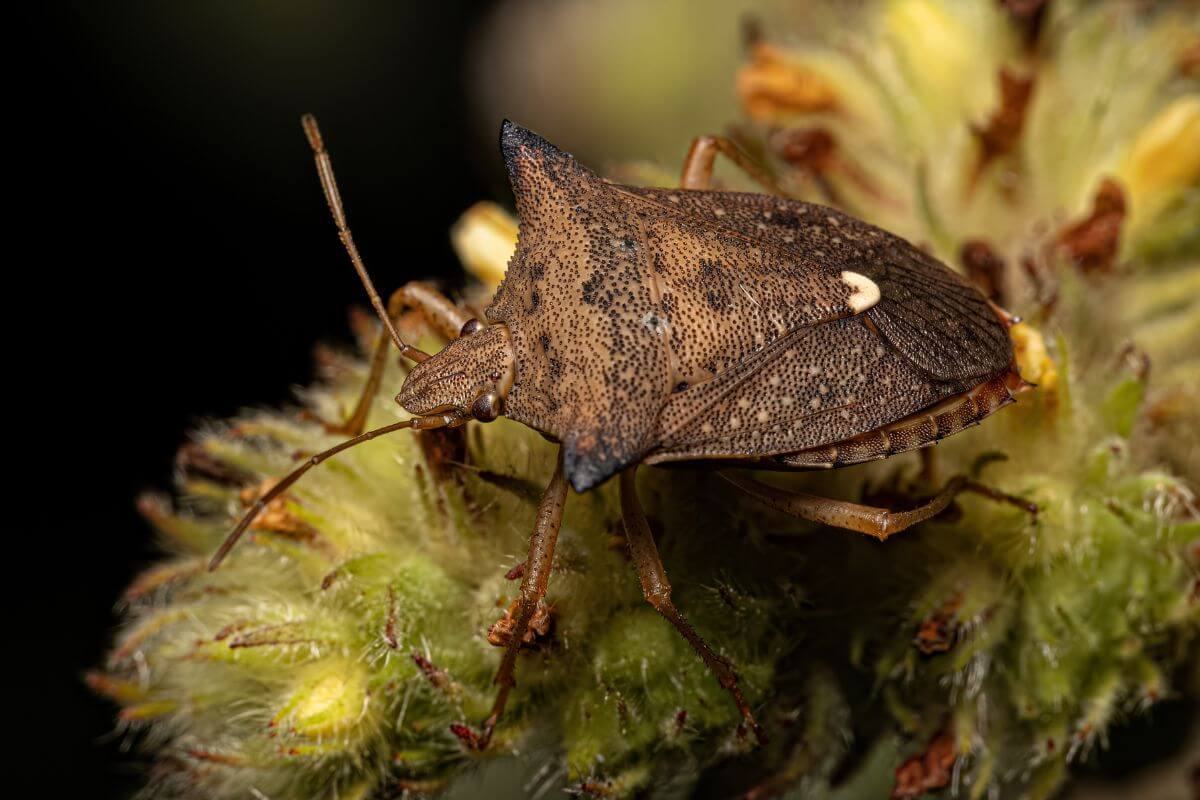
The One Spotted Stink Bug, with the scientific name Euschistus variolarius, is a creature with a voracious appetite and a peculiar way of feeding.
Both adults and nymphs utilize their piercing-sucking mouthparts to extract plant juices, which can have a significant impact on plant growth.
As they indulge in their feeding frenzy, these stink bugs have been known to cause damage to a variety of hosts, including grains, vegetables, fruit trees, and orchards.
But it’s not all about feasting on plants for these stink bugs. Occasionally, they turn the tables and become predators themselves, taking down other insects that cross their path.
When it comes to reproduction, the One Spotted Stink Bug lays eggs that are light green to cream-colored, resembling miniature barrels with a flat top.
What sets these eggs apart are the intriguing club-shaped spines that skirt the round lid at the closed end, numbering from 28 to 30.
As the nymphs emerge from their eggs, they bear a striking resemblance to the adults, albeit in a smaller form. These nymphs gradually develop, and as they grow, subtle wing pads become evident on their bodies.
In terms of physical characteristics, the One Spotted Stink Bug boasts a broad, shield-shaped body that comes in different forms for males and females. While males tend to be elongated and oval, females take on a broader shape.
From their distinctive feeding habits to their role as both plant pests and insect predators, this bug adds complexity to ecological interactions in their habitat.
9. Anchor Stink Bug (Stiretrus anchorage)
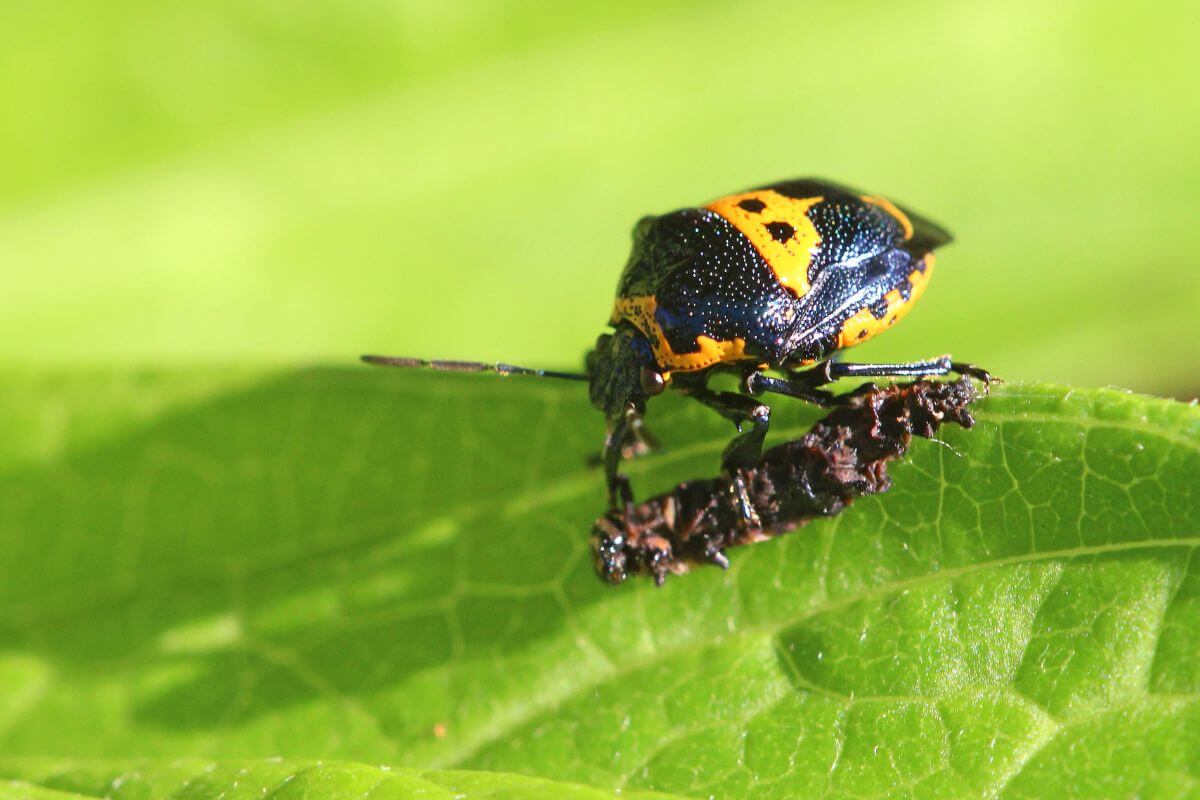
The anchor stink bug, scientifically identified as Stiretrus anchorago, is a fascinating generalist predator, hunting a wide range of prey in the ecosystem.
These true bugs have a specialized beak for capturing prey, using harpoon-like tips to immobilize and consume their victims with digestive enzymes, displaying an ingenious hunting strategy.
One distinctive feature of the Anchor stink bug is the marking on the top of its abdomen, resembling the shape of a ship’s anchor. Additionally, two spots on its thorax are separated by a bold black marking.
These bugs come in various colors, ranging from vibrant yellow and orange to deep red, with contrasting black markings.
While not as numerous as other predatory stink bugs like Podisus, anchor stink bugs are still essential for ecosystem balance, even though they have a more limited population.
10. Say’s Stink Bug (Chlorochroa sayi)
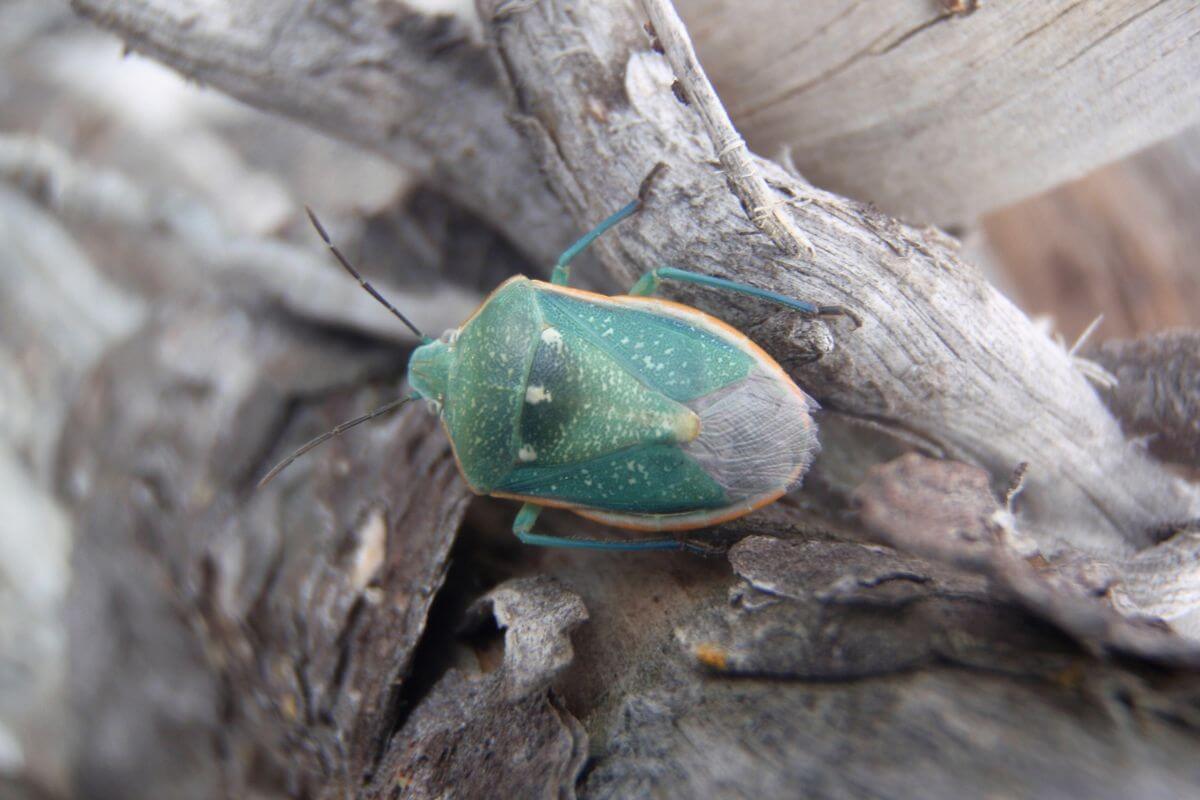
The Say’s Stink Bug (Chlorochroa sayi) stands out with its unique shield featuring three raised orange-yellowish or whitish spots.
When threatened, these bugs unleash their secret weapon–a potent, sour apple-smelling stink spray. It’s like they have their own little perfume factory, ready to ward off any potential predators.
When it comes to their eating habits, Say’s Stink Bugs are herbivorous creatures. They have a wide-ranging diet, happily munching on a variety of crops and common weeds.
In agricultural ecosystems, Say’s Stink Bugs have a complex role as herbivores, potentially affecting crops. Their population dynamics are influenced by natural predators, which help keep their numbers in check.
When encountering these bugs, it’s worth noting their distinct appearance and their role in the ecosystem.
11. Red-Shouldered Stink Bug (Thyanta custator)
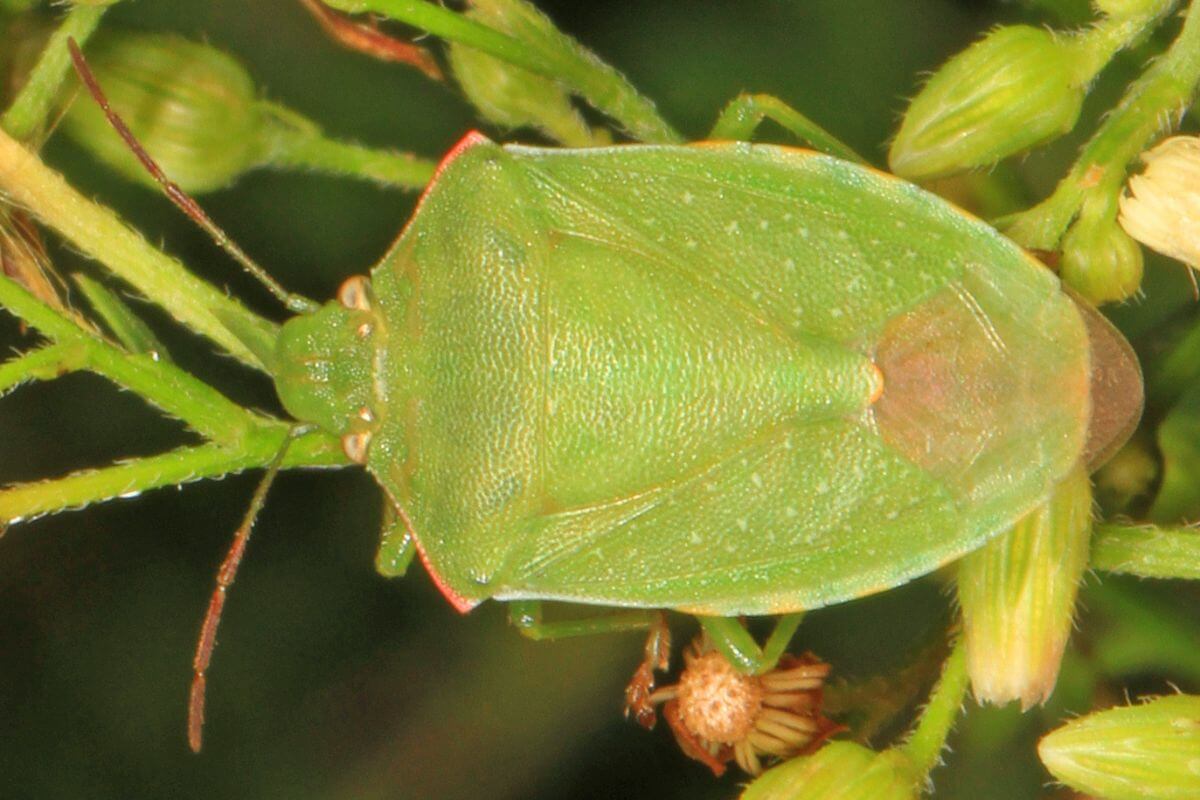
The red-shouldered stink bug, Thyanta custator, measuring almost 12 millimeters in length, stands out with its substantial body and variable pale green to brownish coloration.
These stink bugs are commonly found in wheat, beans, and alfalfa, where they feed on plant matter. Using their piercing-sucking mouthparts, they consume young leaves, flowers, and developing seeds, diversifying their diet in search of sustenance.
Interestingly, when it comes to hemp plants, the red-shouldered stink bug seems to cause little injury.
Reports suggest that any damage is mainly limited to seed production. So, while they may occasionally gather in a batch, their impact on hemp crops seems to be minimal.
Despite their presence as pests, it’s essential to recognize that these bugs also act as prey for other creatures, contributing to ecological balance.
Montana Stink Bugs Final Thoughts
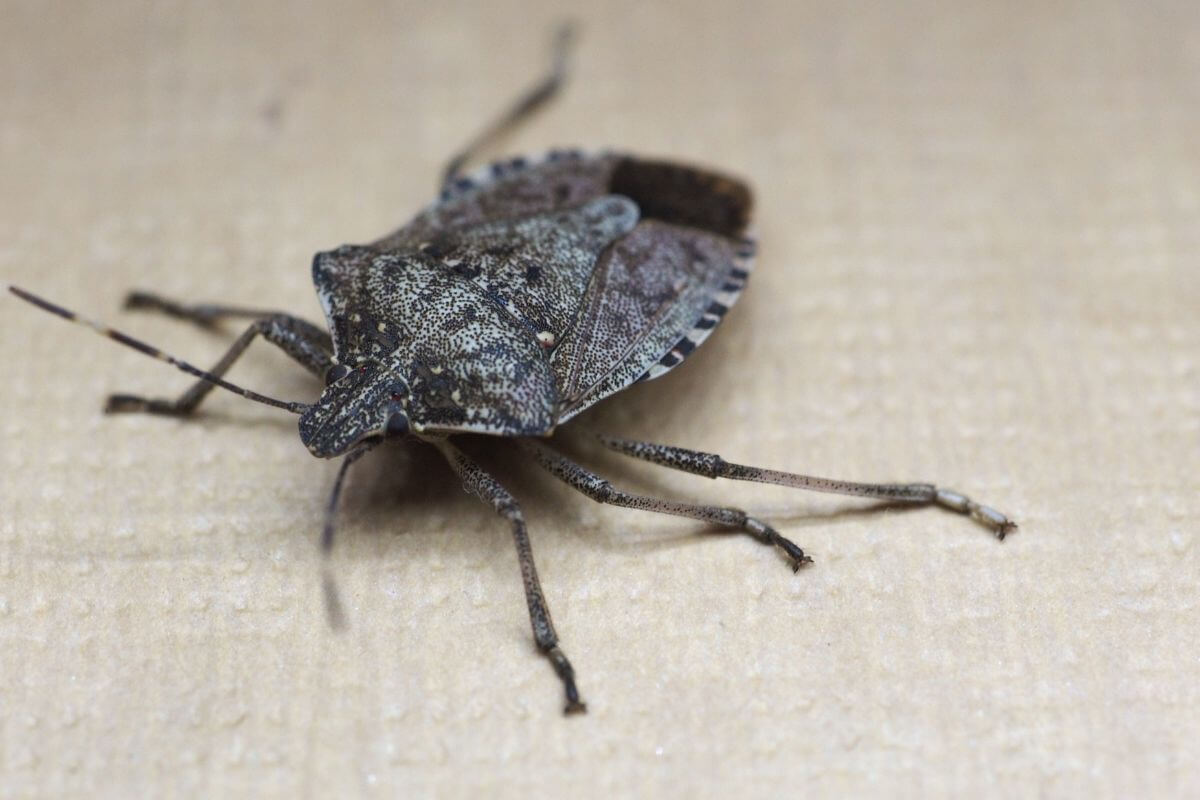
Montana is home to a variety of stink bug species, from the rough stink bug and red-shouldered stink bug to the Spined Soldier Bug and Say’s Stink Bug, each showcasing a range of colors and patterns reflecting their diverse habitats.
They are not picky eaters, indulging in a delectable feast of various plant varieties and, occasionally, like in the case of the One Spotted Stink Bug, other insects.
What makes Montana’s stink bugs truly fascinating is their defense mechanism. When threatened, they release a pungent stink spray with a sour apple-like odor, a defense mechanism in the wild.
Certain species, such as the Brown Marmorated Stink Bug, can be more of a pest than others, necessitating greater control measures.
Meanwhile, species like the blue shieldbug and rough stink bug, play significant roles in ecosystem balance.
In Big Sky Country’s diverse ecosystems, these stink bugs contribute to biodiversity and enhance the region’s ecological complexity.
Montana Stink Bugs FAQs
1. Do Stink Bugs Hurt People?
Stink bugs may be a nuisance, but they do not pose any direct harm to people. Unlike other insects, they do not engage in biting, stinging, or disease transmission.
However, their primary irritation stems from the foul-smelling substance they release as a defense mechanism or when accidentally crushed.
2. What Happens When a Stink Bug Bites Someone?
Stink bugs do not bite people. However, they can still be mildly irritating if they make contact with your skin.
If a stink bug lands on you, it might move around or attempt to fly away, and its legs and body can feel somewhat spiky. This can result in some discomfort, possibly leading to a mild itch or tingling sensation.
3. What Does a Stink Bug Smell Like?
The strong smell emitted by a stink bug can be compared to the fragrance of the culinary herb cilantro. Collectively, it has also been described as something reminiscent of sour apple-scented spray.
Some individuals might describe it as reminiscent of sulfur and ammonia, or even like the odor of spoiled meat.
4. What Happens if a Dog Eats a Stink Bug?
Stink bugs are generally harmless to pets as they do not bite or sting.
However, if a dog or cat happens to ingest a stink bug, it can cause an upset stomach and lead to symptoms like vomiting and diarrhea.
It’s best to keep an eye on your pets and ensure they don’t consume these bugs to avoid any unnecessary discomfort.
5. How Do You Get Rid of Stink Bugs?
To effectively get rid of stink bugs, it is crucial to take certain preventive measures. Start by sealing any openings or cracks in your home to prevent these pesky pests from entering.
Additionally, consider switching to yellow or sodium-vapor exterior light bulbs, as stink bugs are attracted to standard white lights.
Explore more facets of Montana by delving into these exceptional reads:
- https://agresearch.montana.edu/warc/research_current/pests/bmsb.html
- https://ipm.ucanr.edu/natural-enemies/twospotted-stink-bug/
- https://edis.ifas.ufl.edu/publication/IN1176
- https://entnemdept.ufl.edu/creatures/veg/bean/green_stink_bug.htm
- https://entnemdept.ufl.edu/creatures/beneficial/podisus_maculiventris.htm
- https://ipm.ucanr.edu/natural-enemies/rough-stink-bugs/
- https://entomology.ces.ncsu.edu/biological-control-information-center/beneficial-predators/anchor-bug/
- https://webdoc.agsci.colostate.edu/hempinsects/PDFs/Red-shouldered%20Stink%20Bug%20with%20photos.pdf

